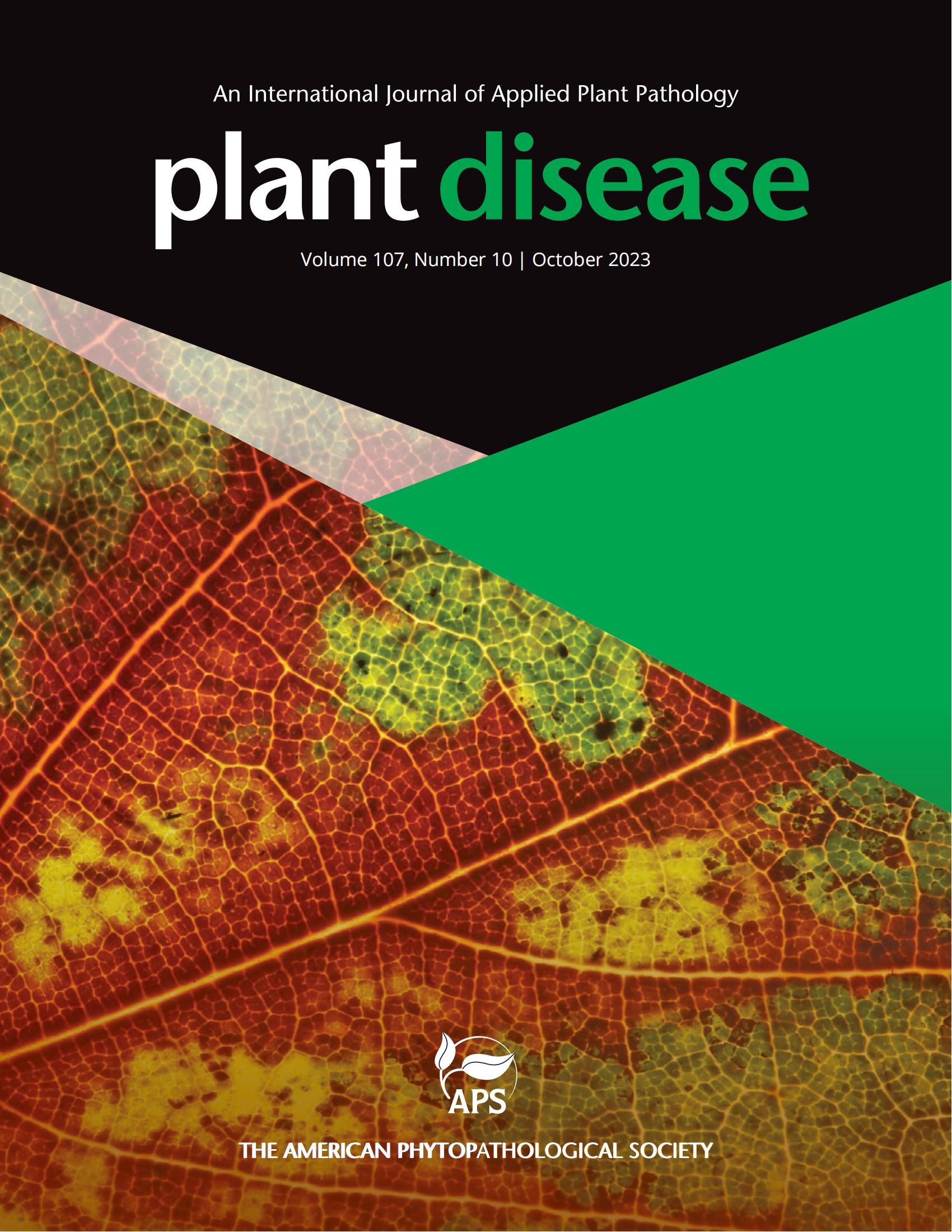新拟多毛opsis clavispora在中国引起章鱼叶枯病的首次报道。
摘要
由于其具有较高的观赏价值和经济价值,在华南地区被广泛种植。2022年4月,在中国湛江(21.20°N, 110.41°E)发现一种章鱼叶病。病害发生率和严重程度分别为15%和20% (n = 100株)。叶片症状最初表现为浅灰色小斑,而后扩大合并为规则或不规则浅灰色坏死灶,边缘暗。从10株植物中采集10片有症状的叶片。从病变边缘切下小块组织(4 × 4 mm),在75%乙醇中表面消毒30秒,然后在1% NaClO中消毒1分钟,用无菌水冲洗三次,镀在马铃薯葡萄糖琼脂(PDA)上,在28°C下孵育。5 d后,从10个叶片样品中分离得到15株形态相似的真菌,并对3株具有代表性的菌株(YZM-1、YZM-2和YZM-3)进行形态和分子鉴定。菌落为白色,有棉质气生菌丝。10 d后,菌落表面散有黑色粘稠的针泡。分生孢子为棍棒状至梭形,四隔,直或微弯,大小为17.57 ~ 25.70 × 4.53 ~ 6.80 μm(平均23.13 × 5.14 μm) (n = 50)。基细胞和根尖细胞无色,三个培养基细胞呈深棕色和杂色。分生孢子有一个单一的基部附属物(4.5 ~ 5.5 μm长;N = 50)和两个或三个顶端附属物(18.2 ~ 33.5 μm长;N = 50)。这些形态特征与Neopestalotiopsis clavispora的描述一致(Maharachchikumbura et al. 2012)。为了进一步鉴定,采用2% CTAB法提取基因组DNA (Lu et al. 2012)。内部转录间隔区(ITS)以及β-微管蛋白2 (tub2)和翻译伸长因子1- α (tef1α)基因分别使用引物ITS1/ITS4、T1/Bt-2b和EF1-728F/EF-2进行扩增(Maharachchikumbura et al. 2012)。ITS (OM721785-87)、tub2 (OQ130413-15)和tef1α (OM810189-91)序列与nclavispora型菌株MFLUCC12-0281 (accession no . JX398979、JX399014和JX399045)的同源性分别为99.38%、99.33%和99.17%。利用ITS、tub2和tef1α的串联序列生成系统发育树。所有三个分离株均与clavispora菌株聚集,包括MFLUCC12-0281型。对10株2年生的八爪虾植株进行致病性试验,在叶片表面喷洒105个分生孢子/ml的分生孢子悬浮液。模拟接种的对照组(n=10)用无菌蒸馏水喷洒。所有植物用聚乙烯袋包裹24 h,在28°C、相对湿度90%的生长室中培养。10 d后,所有接种叶片均表现出与田间相似的症状,而对照叶片无症状。通过形态学和分子特征分析,对该真菌进行了鉴定。致病性试验重复三次,结果相似。据报道,N. clavispora在广泛的宿主中引起疾病(Chen et al. 2018;Borrero et al. 2018),但在S. octophylla中没有。这是中国首次报道引起章鱼叶枯病的clavispora。如果不加以控制,这种病害可能造成重大的经济损失。需要更多的研究来更好地了解这种疾病并制定控制策略。Schefflera octophylla is widely cultivated in South China due to its high ornamental and economic value. In April 2022, a leaf disease on S. octophylla was observed in Zhanjiang (21.20° N, 110.41°E), China. Disease incidence and severity were 15% and 20% (n = 100 investigated plants), respectively. Symptoms on leaves primarily appeared as small light gray spots, then enlarged and coalesced into regular or irregular light gray necrotic lesions with dark margins. Ten symptomatic leaves from 10 plants were collected. Small pieces of tissue (4 × 4 mm) were cut from lesion borders and were surfaced disinfected in 75% ethanol for 30 s, followed by 1 min in 1% NaClO, rinsed three times with sterile water, plated on potato dextrose agar (PDA), and incubated at 28°C. After 5 days, fifteen morphologically similar fungal isolates were obtained from all 10 leaf samples and three representative strains (YZM-1, YZM-2, and YZM-3) were used for morphological and molecular characterization. Colonies were white with cottony aerial mycelium. After 10 days, black viscous acervuli were scattered on the colony surface. Conidia were clavate to fusiform, four-septate, straight or slightly curved, and measured 17.57-25.70 × 4.53-6.80 μm (mean 23.13 × 5.14 μm) in size (n = 50). Basal and apical cells were colorless while the three medium cells were dark brown and versicolor. Conidia had a single basal appendage (4.5 to 5.5 μm long; n = 50) and two or three apical appendages (18.2 to 33.5 μm long; n = 50). These morphological characteristics were consistent with the description of Neopestalotiopsis clavispora (Maharachchikumbura et al. 2012). For further identification, genomic DNA was extracted by the 2% CTAB method (Lu et al. 2012). The internal transcribed spacer (ITS) region and β-tubulin 2 (tub2) and translation elongation factor 1-alpha (tef1α) genes were amplified using the primers ITS1/ITS4, T1/Bt-2b, and EF1-728F/EF-2 respectively (Maharachchikumbura et al. 2012). The ITS (OM721785-87), tub2 (OQ130413-15) and tef1α (OM810189-91) sequences were 99.38%, 99.33%, and 99.17% identical to the N. clavispora type strain MFLUCC12-0281 (accession nos. JX398979, JX399014, and JX399045, respectively). A phylogenetic tree was generated using the concatenated sequences of ITS, tub2, and tef1α. All three isolates clustered with N. clavispora strains including the type MFLUCC12-0281. For pathogenicity tests, 2-year-old S. octophylla plants (n=10) were sprayed with a conidial suspension (105 conidia/ml) on the surface of wounded leaves. Mock-inoculated controls (n=10) were sprayed with sterile distilled water. All plants were wrapped in polyethylene bags for 24 h and incubated at 28°C in a growth chamber at 90% relative humidity. After 10 days, all inoculated leaves showed similar symptoms to those observed in the field, whereas control leaves were asymptomatic. N. clavispora was re-isolated from the lesions and the identity of the fungus was confirmed based on morphology and molecular characterization. The pathogenicity test was repeated three times with similar results. N. clavispora has been reported to cause diseases in a broad range of hosts (Chen et al. 2018; Borrero et al. 2018), but not in S. octophylla. This is the first report of N. clavispora causing leaf blight on S. octophylla in China. Damage caused by N. clavispora could cause significant economic losses if not managed. More research is needed to better understand this disease and establish control strategies.

 求助内容:
求助内容: 应助结果提醒方式:
应助结果提醒方式:


